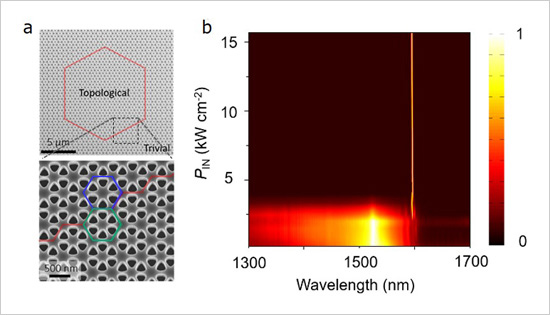 Press Release 2019
Press Release 2019
Discovery of a New Lasing Phenomenon in Honeycomb Structure
—Topology Induces Wave Confinement, Shining Light to the Development of Groundbreaking Microlaser Technologies—
Japan Science and Technology Agency (JST)
A NIMS research team discovered a novel wave confinement induced by the topological property of honeycomb photonic crystals, and succeeded in fabricating a microlaser with excellent directionality. As the key element for innovative technologies in communications, sensors, material processing and DNA manipulation, the high-quality microlaser is expected to be useful for a broad scope of applications.
(”A high-performance topological bulk laser based on band-inversion-induced reflection” Z.-K. Shao, H.-Z. Chen, S. Wang, X.-R. Mao, Z.-Q. Yang, S.-L. Wang, X.-X. Wang, X. Hu and R.-M. Ma; Journal: Nature Nanotechnology, vol. 15, 67-72 (2020); DOI : 10.1038/s41565-019-0584-x)
A “topological material” exhibits physical properties that remain unchanged when it deforms its shape continuously. Topological properties have been a subject of intensive research with the goal of developing novel functions, including quantum computing. These topological properties generally occur locally on the surfaces and edges of a system (bulk-edge correspondence), which enable electric current without any resistance and optical and electromagnetic waves to propagate without being scattered by disorder and crystalline defects. However, it had been unknown whether topological properties could increase the performance of the whole of a system beyond its surfaces and edges.
This research team fabricated a topological laser device composed of a topological, light-emitting semiconductor photonic crystal at the center and a surrounding topologically trivial photonic crystal of the same material. The team then discovered that the interface between the topological and trivial photonic crystals reflects light, amplifying the photonic modes confined in the inner photonic crystal. The unique point of this approach is that, starting from the honeycomb lattice of triangle air holes, the topological and trivial photonic crystals can be fabricated by just shifting the positions of the six triangle holes in a hexagonal unit cell outward and inward from the unit-cell center by a small amount, respectively. Upon pumping light at room temperature, the device emits laser beam vertically to the cavity surface with excellent directionality, despite the device’s small size. As shown in Fig. 1b, the team has also confirmed that the laser characteristics, such as the lasing threshold and side-mode suppression ratio, satisfy the IEEE and other industrial standards.
The topological lasing phenomenon demonstrated in this research may inspire the development of compact, solid-state lasers with excellent directionality. Topological lasers may enable the development of innovative microlaser technologies, ranging from near-field optical microscopes to optical tweezers based on optical vortices, thereby significantly contributing to advances in medicine and life science.
This project was carried out by a research team consisting of Xiao Hu (Principal Investigator, International Center for Materials Nanoarchitectonics (WPI-MANA), NIMS), Xingxiang Wang (NIMS Junior Researcher, MANA, NIMS) and a group led by Renmin Ma (Assistant Professor, Peking University, China). This work was supported partially by the project “Creating topological states and innovative functionality based on artificial graphenes” (grant number: JPMJCR18T4, research director: Xiao Hu) being carried out in the research area “Creation of core technology based on the topological materials science for innovative devices” (research supervisor: Masahito Ueda) funded by the JST Strategic Basic Research Program CREST, and partially by the project “Study on mechanism of emergent topological states and creation of new functionality based on real-space manipulation” (project number: 17H02913, principal investigator: Xiao Hu) funded by JSPS Grants-in-Aid for Scientific Research (B).
This research was published in the online version of Nature Nanotechnology at 4:00 pm on December 16, 2019, GMT.

figure: (a) SEM images of a topological photonic cavity. (b) Laser emission spectra at various pumping powers
(Regarding this research)
Hu Xiao
MANA Principal Investigator, Nano-System Theoretical Physics Group, MANA, NIMS
Tel:+81-29-860-4897
E-Mail:Hu.Xiao=nims.go.jp
(Please change "=" to "@")
(For general inquiries)
Public Relations Office
National Institute for Materials Sciences
Tel:+81-29-859-2026
Fax:+81-29-859-2017
E-Mail:pressrelease=ml.nims.go.jp
(Please change "=" to "@")
Public Relations Division
Department of General Affairs
Tel:+81-3-5214-8404
Fax:+81-3-5214-8432
E-Mail:jstkoho=jst.go.jp
(Please change "=" to "@")
(Regarding the JST Strategic Basic Research Programs)
Tsuyoshi Nakamura
Green Innovation Group,
Department of Strategic Basic Research Japan Science and Technology Agency
Tel:+81-3-3512-3531
Fax:+81-3-3222-2066
E-Mail:crest=jst.go.jp
(Please change "=" to "@")
Japan Science and Technology Agency K's Gobancho, 7 Gobancho, Chiyoda-ku,

